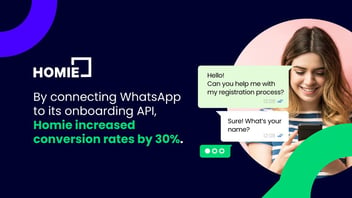In this article you will find:
If we talk about acquiring customers safely and effectively, we also need to talk about digital onboarding; the user's highway to your company! That's why the current trend is to conduct this process through WhatsApp. In this post, I'll tell you all about it.
The incorporation process marks the beginning of your customers' journey to a full experience with your company, and Truora is playing a fundamental role with its digital onboarding services.
It's not just about being fast and precise to ensure identity, creating a frictionless experience that delights and retains, but also about being at the forefront of market interpretation and its trends.
That's why Truora provides cutting-edge technology for you to carry out the customer onboarding process with a lot of security and without friction in the experience. That's what I'll talk about today! In this post, you'll see:
- What is digital onboarding?
- Identity verification
- The market's transition towards portable digital identity solutions
- WhatsApp for your company's digital onboarding
- Harnessing the potential of WhatsApp with Truora
- The 7 key steps to implement an effective digital onboarding process
- Experience a simplified and secure digital onboarding
What is digital onboarding?
Digital onboarding is the process of user entry, incorporation and qualification through online technology. This involves activities such as account creation, digital identity verification, profiling, electronic signature and preference setting.
Its goal is to simplify the user experience, reduce friction and streamline access to a digital service or product. It also facilitates information collection and allows for personalized support during the onboarding process.
In summary, it leverages digital tools to turn the onboarding process into an opportunity to improve the experience.
Identity verification
Identity verification cannot fail; it is the essential process that creates an environment of security and trust while contributing to agreement compliance.
Security and compliance
Being certain of the user's identity prevents fraud and identity theft, creating a space for transactions to take place securely and reliably.
Additionally, it is a legal obligation to protect your customers' data, so it helps you comply with these regulations, avoiding fines and penalties.
Evolution of the buyer's needs
tI's not just about meeting the necessary requirements; it's about understanding that buyers' needs and expectations go beyond that. They expect you to use the information you have about them responsibly and to their benefit.
Their evolution towards more personalized uses reflects the demand for tailored experiences by consumers, with companies now able to offer exceptional onboarding experiences directly on WhatsApp.
The market's transition towards portable digital identity solutions
The relevance of WhatsApp reflects a significant shift towards simple digital identity solutions and the growing consumer demand for control over their information and simplifying identity verification processes.
In this section, I will explain the transition period in the market towards these portable solutions and the challenges it faces in the identity verification process.
Demand for portable digital identity
Every day, the number of online services and applications requiring identity verification increases, but this process can be cumbersome and impractical, often requiring providing the same personal information over and over again.
That's why portable digital identity solutions seek to address this problem by allowing users to control and share their identity information securely and conveniently across multiple platforms and online services.
Challenges in identity verification
As mobile digital identity solutions gain popularity, they also face new challenges, especially regarding the security and authenticity of personal information.
Advances in artificial intelligence (AI) and deepfake technology have made it easier than ever to create false or altered identities that can go unnoticed in identity verification processes.
This poses a significant risk to companies and consumers, as it can lead to fraud and cyberattacks.
WhatsApp for your company's digital onboarding
Now I'll talk about how your company can use WhatsApp to facilitate and streamline the user onboarding process, highlighting its benefits in terms of ease, efficiency, user experience improvement, and acquisition cost reduction.
 |
 |
 |
Ease and efficiency in digital onboarding
Its simple and familiar interface makes it easy for users to interact and complete the digital onboarding process quickly and seamlessly. Additionally, you can conveniently and efficiently send text messages, images and documents, along with the necessary information from your users.
Enhanced user experience
Using WhatsApp for digital onboarding not only simplifies the process for users but also significantly enhances their experience.
By providing them with the option to complete the onboarding process through a platform they already use and are familiar with, you remove entry barriers and reduce friction, increasing the likelihood of users successfully completing the process.
Reduction in acquisition costs
By leveraging a free and widely used messaging platform like WhatsApp, you eliminate the need to invest in expensive marketing or advertising campaigns to attract new users.
Instead, you can directly reach out to your customers and leads through a channel they already actively use, resulting in more cost-effective and efficient customer acquisition.
Harnessing the potential of WhatsApp with Truora
Using WhatsApp for digital onboarding provides a range of significant benefits, and Truora is a company specialized in helping you maximize them
Offer your users a faster, more convenient and satisfactory digital onboarding experience.
The 7 key steps to implement an effective digital onboarding process
Finally, I'll tell you the key steps to carry out this implementation, based on market trends in identity verification.
1 - Define objectives and requirements
The first step is to clearly define the objectives of the process and the requirements necessary to achieve them.
This includes:
- Identifying the stages of the onboarding process
- Defining he information you want to collect from your customers during the process.
- Identifying the security and compliance standards that must be met
2 - Select an identity verification platform
Once the objectives and requirements have been established, it's important to select the identity verification platform. Truora offers the most advanced solutions so you can easily integrate them into your company's digital onboarding process.
3 - Design an intuitive interface
The interface of the digital onboarding process plays a crucial role in the user experience.
Truora's interface is intuitive and easy to use, allowing you to guide your users through the process step by step and enable them to complete identity verification quickly and seamlessly.

4 - Personalize the verification process
It's essential to personalize the identity verification process to suit individual needs and preferences. Truora offers options that allow you to design the process according to specific requirements.
For example, in financial sectors where security is critical, it may be necessary to implement additional verification steps, such as scanning additional documents or biometric verification, to ensure user authenticity.
On the other hand, in e-commerce, a more streamlined verification process may be preferable to not hinder the user experience.
You can also address specific privacy and security concerns by allowing users to choose from different verification methods or adjust the level of information they want to share.
5 - Ensure security and compliance
Security and compliance are critical aspects of the digital onboarding process. Truora ensures this with robust security measures to protect your users' personal information and comply with current privacy and data protection regulations.
6 - Continuously test and optimize
Once you have implemented the digital onboarding process, it's important to conduct comprehensive testing to identify potential issues or areas for improvement. Continuously optimizing the process based on user feedback and identity verification market trends is essential.
7 - Adapt to changes
Last but not least, it's crucial to adapt the digital onboarding process to the changing needs and preferences of users.
This may involve incorporating new technologies and functionalities, as well as regularly updating the interface and process flow to ensure an optimal user experience.
Experience a simplified and secure digital onboarding
Digital onboarding has become a crucial point in the customer journey, and it's necessary to make the most of it to provide maximum security and quality of experience.
If you want to learn more about the topic, explore the use cases of KYC and AML with Truora's digital onboarding.





